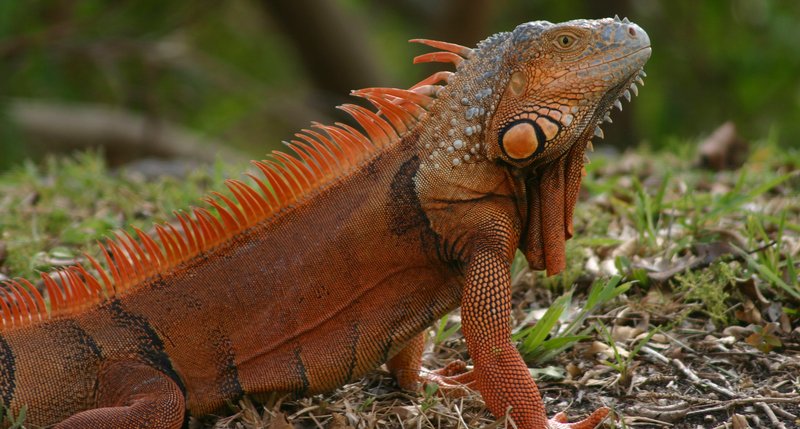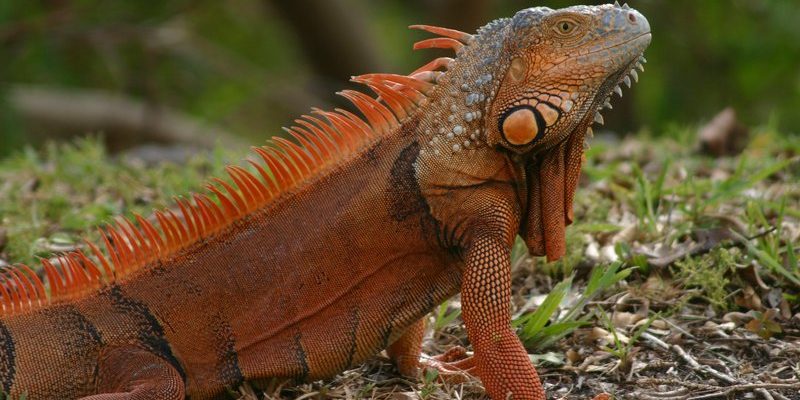
Iguanas belong to the family Iguanidae, and they’re known for their unique physical characteristics, social behaviors, and fascinating adaptations. From their ability to change color to their impressive climbing skills, iguanas are much more than meets the eye. So, if you’re curious about these remarkable lizards, read on! Here are ten facts that might surprise you about these fascinating reptiles.
1. Iguanas Can Grow Really Big
You might be surprised to learn just how large some iguanas can get! The Green Iguana, one of the most common species, can reach lengths of up to 6.5 feet from tip to tail. That’s about as long as a small child! Their weight can also be impressive. Some adult iguanas can weigh between 10 to 20 pounds. Imagine having a pet that’s like a small dog lounging in your living room.
This size isn’t just for show. Iguanas use their bulk to ward off predators. When they feel threatened, they often puff up their bodies to appear larger. And if that doesn’t work, they have a few tricks up their sleeves—like their incredible ability to leap from high branches and glide down to safety. Talk about a great escape!
2. They Have a Unique Diet
Here’s the thing about iguanas: they are primarily herbivores, munching on a diet rich in leafy greens, fruits, and flowers. Unlike some lizards that love to snack on insects, iguanas thrive on a plant-based diet. So, if you’re thinking of getting one as a pet, you’ll need to stock up on kale, dandelion greens, and even hibiscus petals.
Eating a variety of plants not only keeps them healthy but also helps them maintain their vibrant colors. Bright greens and yellows in their diet contribute to those striking hues we associate with iguanas. Just picture a salad bar, but for a lizard!
3. They Can Regulate Their Body Temperature
Did you know that iguanas are ectothermic? This means they can’t internally regulate their body temperature like we do. Instead, they rely on their surroundings. You might find them basking in the sun to soak up heat, or they’ll seek shade to cool down. Imagine lounging by the pool on a hot day—the same idea applies to iguanas!
This unique adaptation is crucial, especially for their digestion. They need warmth to break down food properly. And while they enjoy the sun, too much of it can be dangerous. Just like you wouldn’t stay out in the sun all day without sunscreen, iguanas need occasional breaks to avoid overheating.
4. Iguanas Have an Impressive Sense of Hearing
You might be wondering, “What does hearing have to do with being an iguana?” Well, despite their lack of external ears, iguanas possess a remarkable sense of hearing. They can pick up a wide range of frequencies, which helps them detect potential threats in their environment.
This keen sense allows them to respond quickly to danger, whether it’s a predator or even a human approaching too fast. It’s like having a built-in alarm system! If you’ve ever seen an iguana perk up its head at a nearby sound, you know they’re always on alert.
5. They Have a Third Eye
Iguanas are a bit quirky—did you know they have what’s called a parietal eye? It’s not exactly like a regular eye; it’s more of a light-sensitive spot on the top of their heads. This “third eye” helps iguanas sense movement and changes in light.
While it doesn’t provide a clear image, this special adaptation serves as an early warning system, letting iguanas know if predators are near. Imagine having an extra eye in the back of your head—pretty cool, right?
6. They Can Change Color
If you think chameleons are the only color-changers in the reptile world, think again! Iguanas can display a range of colors, especially when they’re stressed, excited, or trying to communicate. For example, an iguana might turn darker when it’s scared, while brighter colors can signify happiness or readiness to mate.
Interestingly, stress can cause color changes too. If your iguana is feeling threatened or unwell, you might notice it goes from bright green to a dull hue. So, if your iguana suddenly changes colors, pay attention; it might be trying to tell you something!
7. They’re Masters of Climbing
Iguanas are born climbers, thanks to their strong limbs and sharp claws. They can ascend trees and navigate branches with ease, which serves several purposes. First, it helps them escape predators. Being high up offers a safe spot away from ground threats.
Second, climbing allows them to access tasty leaves and fruits that are out of reach for ground-dwelling animals. Think of it like a buffet in the treetops! This skill not only keeps them safe but also ensures they have a steady food supply.
8. Iguanas Have a Unique Social Structure
If you’ve ever seen iguanas hanging out together, you might wonder how they interact. Iguanas are social creatures, and they often engage in intriguing behaviors to establish hierarchy. Larger males tend to dominate smaller ones, and you might see them bobbing their heads or even engaging in chase.
Their social structure can vary from species to species. Some prefer the company of others, while others are more solitary. Understanding these social dynamics is important for anyone considering keeping iguanas as pets, as they may not thrive in isolation.
9. They Can Live a Long Time
Another fascinating fact about iguanas is their impressive lifespan. In captivity, iguanas can live 15 to 20 years or even longer with proper care. That’s a significant commitment! If you adopt one, you need to be prepared for a long-term relationship.
To keep them happy and healthy throughout their lives, proper diet, habitat, and social interactions are crucial. It’s not just about having a cool pet; it’s about creating an environment where they can thrive for years to come.
10. Iguanas Face Conservation Challenges
Finally, it’s essential to mention that many iguana species are facing conservation challenges. Habitat loss due to human activities and pet trade can significantly impact their populations. Some species, like the Galápagos Iguana, are particularly vulnerable.
While iguanas are beautiful and fascinating, supporting conservation efforts is critical to ensuring they continue to thrive in the wild. Consider adopting responsibly or supporting wildlife organizations dedicated to protecting these incredible creatures.
In conclusion, iguanas are more than just colorful lizards. With their large size, unique dietary needs, and impressive adaptability, they are truly fascinating creatures worthy of our appreciation. Whether you admire them in the wild or consider one as a pet, understanding their quirks and needs can enrich your experience. So, next time you come across an iguana, remember these fun facts, and you’ll see them in a whole new light!

